Welcome to the Spring Boot OAuth2 Social Login tutorial series. In this series, we are going to learn how to add Social as well as email and password based login to the Angular + Spring Boot application using Spring Security 5 OAuth2 features and JWT token authentication
What you’ll build
- Spring Boot REST API with OAuth2 Social Login & JWT Authentication
- Angular 10 Client Application to consume the REST API.
Login
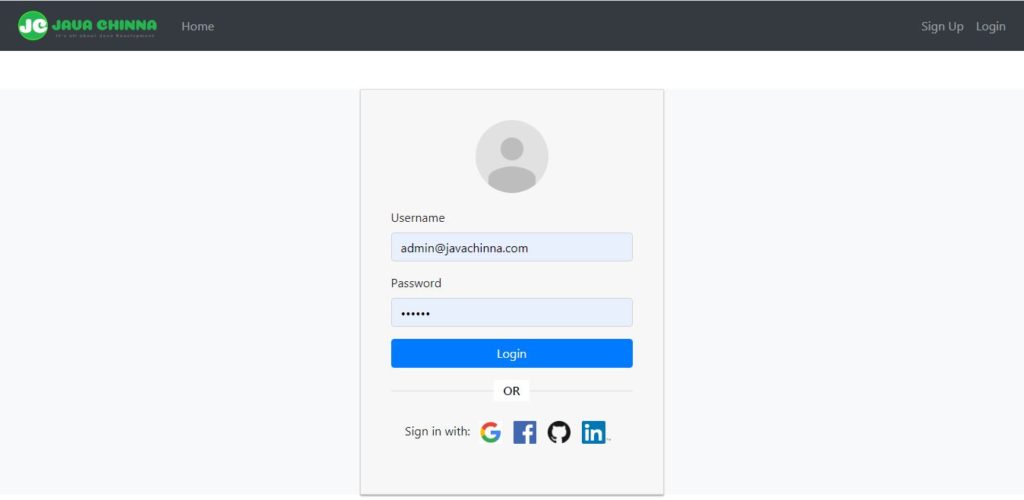
Register
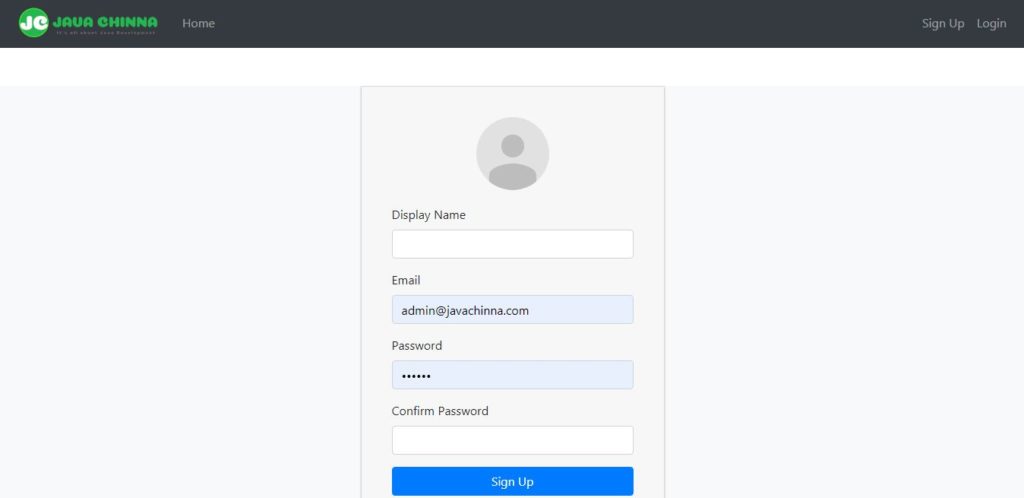
User Home

Admin Home

Admin Profile

What you’ll need
- Spring Tool Suite 4
- JDK 11
- MySQL Server 8
- node.js
Tech Stack
- Spring Boot 2 and Spring Security 5
- Spring Data JPA and Hibernate 5
- Angular 10 and Bootstrap 4
Social Login Configuration
You can follow the steps given in this article to configure Google, Facebook, Github, and LinkedIn for Social Login in Your Spring Boot Angular app.
Application Flow
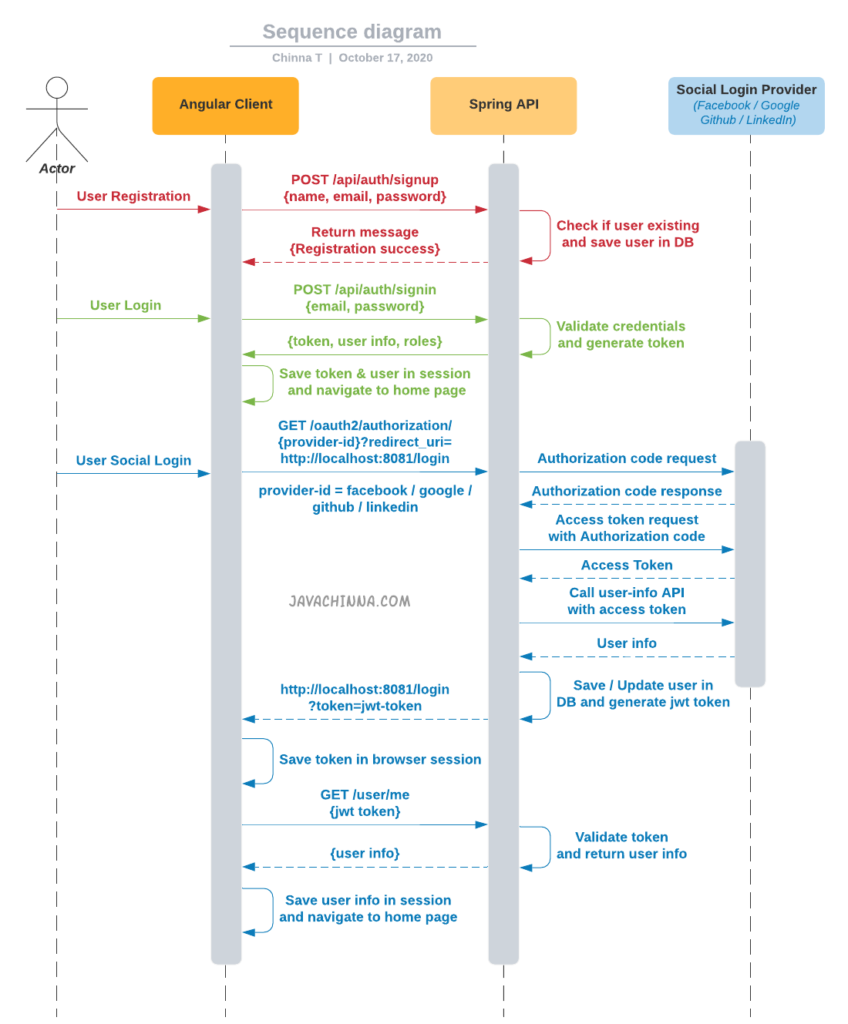
Bootstrap your application
First, we will develop the Spring Boot REST API backend application. You can create your spring boot application with the required dependencies and download it from here
Project Structure
+---pom.xml
|
+---src
| \---main
| +---java
| | \---com
| | \---javachinna
| | | DemoApplication.java
| | |
| | +---config
| | | WebConfig.java
| | | AppProperties.java
| | | CurrentUser.java
| | | RestAuthenticationEntryPoint.java
| | | SetupDataLoader.java
| | | WebSecurityConfig.java
| | |
| | +---controller
| | | AuthController.java
| | | UserController.java
| | |
| | +---dto
| | | ApiResponse.java
| | | JwtAuthenticationResponse.java
| | | LocalUser.java
| | | LoginRequest.java
| | | SignUpRequest.java
| | | SocialProvider.java
| | | UserInfo.java
| | |
| | +---exception
| | | | BadRequestException.java
| | | | OAuth2AuthenticationProcessingException.java
| | | | ResourceNotFoundException.java
| | | | UserAlreadyExistAuthenticationException.java
| | | |
| | | \---handler
| | | RestResponseEntityExceptionHandler.java
| | |
| | +---model
| | | Role.java
| | | User.java
| | |
| | +---repo
| | | RoleRepository.java
| | | UserRepository.java
| | |
| | +---security
| | | +---jwt
| | | | TokenAuthenticationFilter.java
| | | | TokenProvider.java
| | | |
| | | \---oauth2
| | | | CustomOAuth2UserService.java
| | | | CustomOidcUserService.java
| | | | HttpCookieOAuth2AuthorizationRequestRepository.java
| | | | OAuth2AccessTokenResponseConverterWithDefaults.java
| | | | OAuth2AuthenticationFailureHandler.java
| | | | OAuth2AuthenticationSuccessHandler.java
| | | |
| | | \---user
| | | FacebookOAuth2UserInfo.java
| | | GithubOAuth2UserInfo.java
| | | GoogleOAuth2UserInfo.java
| | | LinkedinOAuth2UserInfo.java
| | | OAuth2UserInfo.java
| | | OAuth2UserInfoFactory.java
| | |
| | +---service
| | | LocalUserDetailService.java
| | | UserService.java
| | | UserServiceImpl.java
| | |
| | +---util
| | | CookieUtils.java
| | | GeneralUtils.java
| | |
| | \---validator
| | PasswordMatches.java
| | PasswordMatchesValidator.java
| |
| \---resources
| application.properties
| messages_en.properties
Project Dependencies
pom.xml
<?xml version="1.0" encoding="UTF-8"?>
<project xmlns="http://maven.apache.org/POM/4.0.0" xmlns:xsi="http://www.w3.org/2001/XMLSchema-instance"
xsi:schemaLocation="http://maven.apache.org/POM/4.0.0 https://maven.apache.org/xsd/maven-4.0.0.xsd">
<modelVersion>4.0.0</modelVersion>
<parent>
<groupId>org.springframework.boot</groupId>
<artifactId>spring-boot-starter-parent</artifactId>
<version>2.3.4.RELEASE</version>
<relativePath /> <!-- lookup parent from repository -->
</parent>
<groupId>com.javachinna</groupId>
<artifactId>demo</artifactId>
<version>0.0.1-SNAPSHOT</version>
<name>demo</name>
<description>Demo project for Spring Boot</description>
<properties>
<java.version>11</java.version>
</properties>
<dependencies>
<dependency>
<groupId>org.springframework.boot</groupId>
<artifactId>spring-boot-starter-data-jpa</artifactId>
</dependency>
<dependency>
<groupId>org.springframework.boot</groupId>
<artifactId>spring-boot-starter-oauth2-client</artifactId>
</dependency>
<dependency>
<groupId>org.springframework.boot</groupId>
<artifactId>spring-boot-starter-web</artifactId>
</dependency>
<dependency>
<groupId>org.springframework.boot</groupId>
<artifactId>spring-boot-starter-validation</artifactId>
</dependency>
<dependency>
<groupId>io.jsonwebtoken</groupId>
<artifactId>jjwt</artifactId>
<version>0.9.1</version>
</dependency>
<!-- mysql driver -->
<dependency>
<groupId>mysql</groupId>
<artifactId>mysql-connector-java</artifactId>
</dependency>
<dependency>
<groupId>org.springframework.boot</groupId>
<artifactId>spring-boot-starter-test</artifactId>
<scope>test</scope>
</dependency>
<dependency>
<groupId>org.springframework.boot</groupId>
<artifactId>spring-boot-devtools</artifactId>
</dependency>
<dependency>
<groupId>org.projectlombok</groupId>
<artifactId>lombok</artifactId>
</dependency>
<dependency>
<groupId>org.springframework.boot</groupId>
<artifactId>spring-boot-configuration-processor</artifactId>
<optional>true</optional>
</dependency>
</dependencies>
<build>
<plugins>
<plugin>
<groupId>org.springframework.boot</groupId>
<artifactId>spring-boot-maven-plugin</artifactId>
</plugin>
</plugins>
</build>
</project>
Creating JPA Entities
User.java
package com.javachinna.model;
import java.io.Serializable;
import java.util.Date;
import java.util.Set;
import javax.persistence.Column;
import javax.persistence.Entity;
import javax.persistence.GeneratedValue;
import javax.persistence.GenerationType;
import javax.persistence.Id;
import javax.persistence.JoinColumn;
import javax.persistence.JoinTable;
import javax.persistence.ManyToMany;
import javax.persistence.Temporal;
import javax.persistence.TemporalType;
import com.fasterxml.jackson.annotation.JsonIgnore;
import lombok.Getter;
import lombok.NoArgsConstructor;
import lombok.Setter;
/**
* The persistent class for the user database table.
*
*/
@Entity
@NoArgsConstructor
@Getter
@Setter
public class User implements Serializable {
/**
*
*/
private static final long serialVersionUID = 65981149772133526L;
@Id
@GeneratedValue(strategy = GenerationType.IDENTITY)
@Column(name = "USER_ID")
private Long id;
@Column(name = "PROVIDER_USER_ID")
private String providerUserId;
private String email;
@Column(name = "enabled", columnDefinition = "BIT", length = 1)
private boolean enabled;
@Column(name = "DISPLAY_NAME")
private String displayName;
@Column(name = "created_date", nullable = false, updatable = false)
@Temporal(TemporalType.TIMESTAMP)
protected Date createdDate;
@Temporal(TemporalType.TIMESTAMP)
protected Date modifiedDate;
private String password;
private String provider;
// bi-directional many-to-many association to Role
@JsonIgnore
@ManyToMany
@JoinTable(name = "user_role", joinColumns = { @JoinColumn(name = "USER_ID") }, inverseJoinColumns = { @JoinColumn(name = "ROLE_ID") })
private Set<Role> roles;
}
Role.java
package com.javachinna.model;
import java.io.Serializable;
import java.util.Set;
import javax.persistence.Column;
import javax.persistence.Entity;
import javax.persistence.GeneratedValue;
import javax.persistence.GenerationType;
import javax.persistence.Id;
import javax.persistence.ManyToMany;
import lombok.Getter;
import lombok.NoArgsConstructor;
import lombok.Setter;
/**
* The persistent class for the role database table.
*
*/
@Entity
@Getter
@Setter
@NoArgsConstructor
public class Role implements Serializable {
private static final long serialVersionUID = 1L;
public static final String USER = "USER";
public static final String ROLE_USER = "ROLE_USER";
public static final String ROLE_ADMIN = "ROLE_ADMIN";
public static final String ROLE_MODERATOR = "ROLE_MODERATOR";
@Id
@GeneratedValue(strategy = GenerationType.IDENTITY)
@Column(name = "ROLE_ID")
private Long roleId;
private String name;
// bi-directional many-to-many association to User
@ManyToMany(mappedBy = "roles")
private Set<User> users;
public Role(String name) {
this.name = name;
}
@Override
public int hashCode() {
final int prime = 31;
int result = 1;
result = prime * result + ((name == null) ? 0 : name.hashCode());
return result;
}
@Override
public boolean equals(final Object obj) {
if (this == obj) {
return true;
}
if (obj == null) {
return false;
}
if (getClass() != obj.getClass()) {
return false;
}
final Role role = (Role) obj;
if (!role.equals(role.name)) {
return false;
}
return true;
}
@Override
public String toString() {
final StringBuilder builder = new StringBuilder();
builder.append("Role [name=").append(name).append("]").append("[id=").append(roleId).append("]");
return builder.toString();
}
}
Creating Spring Data JPA Repositories
UserRepository.java
package com.javachinna.repo;
import org.springframework.data.jpa.repository.JpaRepository;
import org.springframework.stereotype.Repository;
import com.javachinna.model.User;
@Repository
public interface UserRepository extends JpaRepository<User, Long> {
User findByEmail(String email);
boolean existsByEmail(String email);
}
RoleRepository.java
package com.javachinna.repo;
import org.springframework.data.jpa.repository.JpaRepository;
import org.springframework.stereotype.Repository;
import com.javachinna.model.Role;
@Repository
public interface RoleRepository extends JpaRepository<Role, Long> {
Role findByName(String name);
}
Creating Service Layer to Access the Repositories
UserService.java
package com.javachinna.service;
import java.util.Map;
import java.util.Optional;
import org.springframework.security.oauth2.core.oidc.OidcIdToken;
import org.springframework.security.oauth2.core.oidc.OidcUserInfo;
import com.javachinna.dto.LocalUser;
import com.javachinna.dto.SignUpRequest;
import com.javachinna.exception.UserAlreadyExistAuthenticationException;
import com.javachinna.model.User;
/**
* @author Chinna
* @since 26/3/18
*/
public interface UserService {
public User registerNewUser(SignUpRequest signUpRequest) throws UserAlreadyExistAuthenticationException;
User findUserByEmail(String email);
Optional<User> findUserById(Long id);
LocalUser processUserRegistration(String registrationId, Map<String, Object> attributes, OidcIdToken idToken, OidcUserInfo userInfo);
}
UserServiceImpl.java
package com.javachinna.service;
import java.util.Calendar;
import java.util.Date;
import java.util.HashSet;
import java.util.Map;
import java.util.Optional;
import org.springframework.beans.factory.annotation.Autowired;
import org.springframework.security.crypto.password.PasswordEncoder;
import org.springframework.security.oauth2.core.oidc.OidcIdToken;
import org.springframework.security.oauth2.core.oidc.OidcUserInfo;
import org.springframework.stereotype.Service;
import org.springframework.transaction.annotation.Transactional;
import org.springframework.util.StringUtils;
import com.javachinna.dto.LocalUser;
import com.javachinna.dto.SignUpRequest;
import com.javachinna.dto.SocialProvider;
import com.javachinna.exception.OAuth2AuthenticationProcessingException;
import com.javachinna.exception.UserAlreadyExistAuthenticationException;
import com.javachinna.model.Role;
import com.javachinna.model.User;
import com.javachinna.repo.RoleRepository;
import com.javachinna.repo.UserRepository;
import com.javachinna.security.oauth2.user.OAuth2UserInfo;
import com.javachinna.security.oauth2.user.OAuth2UserInfoFactory;
import com.javachinna.util.GeneralUtils;
/**
* @author Chinna
* @since 26/3/18
*/
@Service
public class UserServiceImpl implements UserService {
@Autowired
private UserRepository userRepository;
@Autowired
private RoleRepository roleRepository;
@Autowired
private PasswordEncoder passwordEncoder;
@Override
@Transactional(value = "transactionManager")
public User registerNewUser(final SignUpRequest signUpRequest) throws UserAlreadyExistAuthenticationException {
if (signUpRequest.getUserID() != null && userRepository.existsById(signUpRequest.getUserID())) {
throw new UserAlreadyExistAuthenticationException("User with User id " + signUpRequest.getUserID() + " already exist");
} else if (userRepository.existsByEmail(signUpRequest.getEmail())) {
throw new UserAlreadyExistAuthenticationException("User with email id " + signUpRequest.getEmail() + " already exist");
}
User user = buildUser(signUpRequest);
Date now = Calendar.getInstance().getTime();
user.setCreatedDate(now);
user.setModifiedDate(now);
user = userRepository.save(user);
userRepository.flush();
return user;
}
private User buildUser(final SignUpRequest formDTO) {
User user = new User();
user.setDisplayName(formDTO.getDisplayName());
user.setEmail(formDTO.getEmail());
user.setPassword(passwordEncoder.encode(formDTO.getPassword()));
final HashSet<Role> roles = new HashSet<Role>();
roles.add(roleRepository.findByName(Role.ROLE_USER));
user.setRoles(roles);
user.setProvider(formDTO.getSocialProvider().getProviderType());
user.setEnabled(true);
user.setProviderUserId(formDTO.getProviderUserId());
return user;
}
@Override
public User findUserByEmail(final String email) {
return userRepository.findByEmail(email);
}
@Override
@Transactional
public LocalUser processUserRegistration(String registrationId, Map<String, Object> attributes, OidcIdToken idToken, OidcUserInfo userInfo) {
OAuth2UserInfo oAuth2UserInfo = OAuth2UserInfoFactory.getOAuth2UserInfo(registrationId, attributes);
if (StringUtils.isEmpty(oAuth2UserInfo.getName())) {
throw new OAuth2AuthenticationProcessingException("Name not found from OAuth2 provider");
} else if (StringUtils.isEmpty(oAuth2UserInfo.getEmail())) {
throw new OAuth2AuthenticationProcessingException("Email not found from OAuth2 provider");
}
SignUpRequest userDetails = toUserRegistrationObject(registrationId, oAuth2UserInfo);
User user = findUserByEmail(oAuth2UserInfo.getEmail());
if (user != null) {
if (!user.getProvider().equals(registrationId) && !user.getProvider().equals(SocialProvider.LOCAL.getProviderType())) {
throw new OAuth2AuthenticationProcessingException(
"Looks like you're signed up with " + user.getProvider() + " account. Please use your " + user.getProvider() + " account to login.");
}
user = updateExistingUser(user, oAuth2UserInfo);
} else {
user = registerNewUser(userDetails);
}
return LocalUser.create(user, attributes, idToken, userInfo);
}
private User updateExistingUser(User existingUser, OAuth2UserInfo oAuth2UserInfo) {
existingUser.setDisplayName(oAuth2UserInfo.getName());
return userRepository.save(existingUser);
}
private SignUpRequest toUserRegistrationObject(String registrationId, OAuth2UserInfo oAuth2UserInfo) {
return SignUpRequest.getBuilder().addProviderUserID(oAuth2UserInfo.getId()).addDisplayName(oAuth2UserInfo.getName()).addEmail(oAuth2UserInfo.getEmail())
.addSocialProvider(GeneralUtils.toSocialProvider(registrationId)).addPassword("changeit").build();
}
@Override
public Optional<User> findUserById(Long id) {
return userRepository.findById(id);
}
}
Note: For users who signed up using a social login provider, you can provide a link to reset the password once they logged in. This way they will be able to login using their credentials as well.
Implementing Spring UserDetailsService
LocalUserDetailService.java
package com.javachinna.service;
import org.springframework.beans.factory.annotation.Autowired;
import org.springframework.security.core.userdetails.UserDetailsService;
import org.springframework.security.core.userdetails.UsernameNotFoundException;
import org.springframework.stereotype.Service;
import org.springframework.transaction.annotation.Transactional;
import com.javachinna.dto.LocalUser;
import com.javachinna.exception.ResourceNotFoundException;
import com.javachinna.model.User;
import com.javachinna.util.GeneralUtils;
/**
*
* @author Chinna
*
*/
@Service("localUserDetailService")
public class LocalUserDetailService implements UserDetailsService {
@Autowired
private UserService userService;
@Override
@Transactional
public LocalUser loadUserByUsername(final String email) throws UsernameNotFoundException {
User user = userService.findUserByEmail(email);
if (user == null) {
throw new UsernameNotFoundException("User " + email + " was not found in the database");
}
return createLocalUser(user);
}
@Transactional
public LocalUser loadUserById(Long id) {
User user = userService.findUserById(id).orElseThrow(() -> new ResourceNotFoundException("User", "id", id));
return createLocalUser(user);
}
/**
* @param user
* @return
*/
private LocalUser createLocalUser(User user) {
return new LocalUser(user.getEmail(), user.getPassword(), user.isEnabled(), true, true, true, GeneralUtils.buildSimpleGrantedAuthorities(user.getRoles()), user);
}
}
Creating Validators
PasswordMatches.java
package com.javachinna.validator;
import static java.lang.annotation.ElementType.ANNOTATION_TYPE;
import static java.lang.annotation.ElementType.TYPE;
import static java.lang.annotation.RetentionPolicy.RUNTIME;
import java.lang.annotation.Documented;
import java.lang.annotation.Retention;
import java.lang.annotation.Target;
import javax.validation.Constraint;
import javax.validation.Payload;
@Target({ TYPE, ANNOTATION_TYPE })
@Retention(RUNTIME)
@Constraint(validatedBy = PasswordMatchesValidator.class)
@Documented
public @interface PasswordMatches {
String message() default "Passwords don't match";
Class<?>[] groups() default {};
Class<? extends Payload>[] payload() default {};
}
PasswordMatchesValidator.java
package com.javachinna.validator;
import javax.validation.ConstraintValidator;
import javax.validation.ConstraintValidatorContext;
import com.javachinna.dto.SignUpRequest;
public class PasswordMatchesValidator implements ConstraintValidator<PasswordMatches, SignUpRequest> {
@Override
public boolean isValid(final SignUpRequest user, final ConstraintValidatorContext context) {
return user.getPassword().equals(user.getMatchingPassword());
}
}
Creating DTOs
ApiResponse.java
package com.javachinna.dto;
import lombok.Value;
@Value
public class ApiResponse {
private Boolean success;
private String message;
}
JwtAuthenticationResponse.java
package com.javachinna.dto;
import lombok.Value;
@Value
public class JwtAuthenticationResponse {
private String accessToken;
private UserInfo user;
}
LocalUser.java
package com.javachinna.dto;
import java.util.Collection;
import java.util.Map;
import org.springframework.security.core.GrantedAuthority;
import org.springframework.security.core.userdetails.User;
import org.springframework.security.oauth2.core.oidc.OidcIdToken;
import org.springframework.security.oauth2.core.oidc.OidcUserInfo;
import org.springframework.security.oauth2.core.oidc.user.OidcUser;
import org.springframework.security.oauth2.core.user.OAuth2User;
import com.javachinna.util.GeneralUtils;
/**
*
* @author Chinna
*
*/
public class LocalUser extends User implements OAuth2User, OidcUser {
/**
*
*/
private static final long serialVersionUID = -2845160792248762779L;
private final OidcIdToken idToken;
private final OidcUserInfo userInfo;
private Map<String, Object> attributes;
private com.javachinna.model.User user;
public LocalUser(final String userID, final String password, final boolean enabled, final boolean accountNonExpired, final boolean credentialsNonExpired,
final boolean accountNonLocked, final Collection<? extends GrantedAuthority> authorities, final com.javachinna.model.User user) {
this(userID, password, enabled, accountNonExpired, credentialsNonExpired, accountNonLocked, authorities, user, null, null);
}
public LocalUser(final String userID, final String password, final boolean enabled, final boolean accountNonExpired, final boolean credentialsNonExpired,
final boolean accountNonLocked, final Collection<? extends GrantedAuthority> authorities, final com.javachinna.model.User user, OidcIdToken idToken,
OidcUserInfo userInfo) {
super(userID, password, enabled, accountNonExpired, credentialsNonExpired, accountNonLocked, authorities);
this.user = user;
this.idToken = idToken;
this.userInfo = userInfo;
}
public static LocalUser create(com.javachinna.model.User user, Map<String, Object> attributes, OidcIdToken idToken, OidcUserInfo userInfo) {
LocalUser localUser = new LocalUser(user.getEmail(), user.getPassword(), user.isEnabled(), true, true, true, GeneralUtils.buildSimpleGrantedAuthorities(user.getRoles()),
user, idToken, userInfo);
localUser.setAttributes(attributes);
return localUser;
}
public void setAttributes(Map<String, Object> attributes) {
this.attributes = attributes;
}
@Override
public String getName() {
return this.user.getDisplayName();
}
@Override
public Map<String, Object> getAttributes() {
return this.attributes;
}
@Override
public Map<String, Object> getClaims() {
return this.attributes;
}
@Override
public OidcUserInfo getUserInfo() {
return this.userInfo;
}
@Override
public OidcIdToken getIdToken() {
return this.idToken;
}
public com.javachinna.model.User getUser() {
return user;
}
}
LoginRequest.java
package com.javachinna.dto;
import javax.validation.constraints.NotBlank;
import lombok.Data;
@Data
public class LoginRequest {
@NotBlank
private String email;
@NotBlank
private String password;
}
SignUpRequest.java
package com.javachinna.dto;
import javax.validation.constraints.NotEmpty;
import javax.validation.constraints.Size;
import com.javachinna.validator.PasswordMatches;
import lombok.Data;
/**
* @author Chinna
* @since 26/3/18
*/
@Data
@PasswordMatches
public class SignUpRequest {
private Long userID;
private String providerUserId;
@NotEmpty
private String displayName;
@NotEmpty
private String email;
private SocialProvider socialProvider;
@Size(min = 6, message = "{Size.userDto.password}")
private String password;
@NotEmpty
private String matchingPassword;
public SignUpRequest(String providerUserId, String displayName, String email, String password, SocialProvider socialProvider) {
this.providerUserId = providerUserId;
this.displayName = displayName;
this.email = email;
this.password = password;
this.socialProvider = socialProvider;
}
public static Builder getBuilder() {
return new Builder();
}
public static class Builder {
private String providerUserID;
private String displayName;
private String email;
private String password;
private SocialProvider socialProvider;
public Builder addProviderUserID(final String userID) {
this.providerUserID = userID;
return this;
}
public Builder addDisplayName(final String displayName) {
this.displayName = displayName;
return this;
}
public Builder addEmail(final String email) {
this.email = email;
return this;
}
public Builder addPassword(final String password) {
this.password = password;
return this;
}
public Builder addSocialProvider(final SocialProvider socialProvider) {
this.socialProvider = socialProvider;
return this;
}
public SignUpRequest build() {
return new SignUpRequest(providerUserID, displayName, email, password, socialProvider);
}
}
}
SocialProvider.java
package com.javachinna.dto;
/**
* @author Chinna
* @since 26/3/18
*/
public enum SocialProvider {
FACEBOOK("facebook"), TWITTER("twitter"), LINKEDIN("linkedin"), GOOGLE("google"), GITHUB("github"), LOCAL("local");
private String providerType;
public String getProviderType() {
return providerType;
}
SocialProvider(final String providerType) {
this.providerType = providerType;
}
}
UserInfo.java
package com.javachinna.dto;
import java.util.List;
import lombok.Value;
@Value
public class UserInfo {
private String id, displayName, email;
private List<String> roles;
}
Creating Utility Classes
GeneralUtils.java
package com.javachinna.util;
import java.util.ArrayList;
import java.util.List;
import java.util.Set;
import java.util.stream.Collectors;
import org.springframework.security.core.authority.SimpleGrantedAuthority;
import com.javachinna.dto.LocalUser;
import com.javachinna.dto.SocialProvider;
import com.javachinna.dto.UserInfo;
import com.javachinna.model.Role;
import com.javachinna.model.User;
/**
*
* @author Chinna
*
*/
public class GeneralUtils {
public static List<SimpleGrantedAuthority> buildSimpleGrantedAuthorities(final Set<Role> roles) {
List<SimpleGrantedAuthority> authorities = new ArrayList<>();
for (Role role : roles) {
authorities.add(new SimpleGrantedAuthority(role.getName()));
}
return authorities;
}
public static SocialProvider toSocialProvider(String providerId) {
for (SocialProvider socialProvider : SocialProvider.values()) {
if (socialProvider.getProviderType().equals(providerId)) {
return socialProvider;
}
}
return SocialProvider.LOCAL;
}
public static UserInfo buildUserInfo(LocalUser localUser) {
List<String> roles = localUser.getAuthorities().stream().map(item -> item.getAuthority()).collect(Collectors.toList());
User user = localUser.getUser();
return new UserInfo(user.getId().toString(), user.getDisplayName(), user.getEmail(), roles);
}
}
CookieUtils.java
package com.javachinna.util;
import java.util.Base64;
import java.util.Optional;
import javax.servlet.http.Cookie;
import javax.servlet.http.HttpServletRequest;
import javax.servlet.http.HttpServletResponse;
import org.springframework.util.SerializationUtils;
public class CookieUtils {
public static Optional<Cookie> getCookie(HttpServletRequest request, String name) {
Cookie[] cookies = request.getCookies();
if (cookies != null && cookies.length > 0) {
for (Cookie cookie : cookies) {
if (cookie.getName().equals(name)) {
return Optional.of(cookie);
}
}
}
return Optional.empty();
}
public static void addCookie(HttpServletResponse response, String name, String value, int maxAge) {
Cookie cookie = new Cookie(name, value);
cookie.setPath("/");
cookie.setHttpOnly(true);
cookie.setMaxAge(maxAge);
response.addCookie(cookie);
}
public static void deleteCookie(HttpServletRequest request, HttpServletResponse response, String name) {
Cookie[] cookies = request.getCookies();
if (cookies != null && cookies.length > 0) {
for (Cookie cookie : cookies) {
if (cookie.getName().equals(name)) {
cookie.setValue("");
cookie.setPath("/");
cookie.setMaxAge(0);
response.addCookie(cookie);
}
}
}
}
public static String serialize(Object object) {
return Base64.getUrlEncoder().encodeToString(SerializationUtils.serialize(object));
}
public static <T> T deserialize(Cookie cookie, Class<T> cls) {
return cls.cast(SerializationUtils.deserialize(Base64.getUrlDecoder().decode(cookie.getValue())));
}
}
Creating Custom Exceptions
BadRequestException.java
package com.javachinna.exception;
import org.springframework.http.HttpStatus;
import org.springframework.web.bind.annotation.ResponseStatus;
@ResponseStatus(HttpStatus.BAD_REQUEST)
public class BadRequestException extends RuntimeException {
private static final long serialVersionUID = 752858877580882829L;
public BadRequestException(String message) {
super(message);
}
public BadRequestException(String message, Throwable cause) {
super(message, cause);
}
}
OAuth2AuthenticationProcessingException.java
package com.javachinna.exception;
import org.springframework.security.core.AuthenticationException;
public class OAuth2AuthenticationProcessingException extends AuthenticationException {
private static final long serialVersionUID = 3392450042101522832L;
public OAuth2AuthenticationProcessingException(String msg, Throwable t) {
super(msg, t);
}
public OAuth2AuthenticationProcessingException(String msg) {
super(msg);
}
}
ResourceNotFoundException.java
package com.javachinna.exception;
import org.springframework.http.HttpStatus;
import org.springframework.web.bind.annotation.ResponseStatus;
import lombok.Getter;
@Getter
@ResponseStatus(HttpStatus.NOT_FOUND)
public class ResourceNotFoundException extends RuntimeException {
private static final long serialVersionUID = 7004203416628447047L;
private String resourceName;
private String fieldName;
private Object fieldValue;
public ResourceNotFoundException(String resourceName, String fieldName, Object fieldValue) {
super(String.format("%s not found with %s : '%s'", resourceName, fieldName, fieldValue));
this.resourceName = resourceName;
this.fieldName = fieldName;
this.fieldValue = fieldValue;
}
}
UserAlreadyExistAuthenticationException.java
package com.javachinna.exception;
import org.springframework.security.core.AuthenticationException;
/**
*
* @author Chinna
*
*/
public class UserAlreadyExistAuthenticationException extends AuthenticationException {
private static final long serialVersionUID = 5570981880007077317L;
public UserAlreadyExistAuthenticationException(final String msg) {
super(msg);
}
}
Creating REST Exception Handler
ResponseEntityExceptionHandler provides centralized exception handling across all @RequestMapping methods through @ExceptionHandler methods.
RestResponseEntityExceptionHandler extends ResponseEntityExceptionHandler and overrides handleMethodArgumentNotValid method to provide a detailed error message with all the validation errors in the response.
RestResponseEntityExceptionHandler.java
package com.javachinna.exception.handler;
import java.util.stream.Collectors;
import org.springframework.http.HttpHeaders;
import org.springframework.http.HttpStatus;
import org.springframework.http.ResponseEntity;
import org.springframework.validation.BindingResult;
import org.springframework.validation.FieldError;
import org.springframework.web.bind.MethodArgumentNotValidException;
import org.springframework.web.bind.annotation.ControllerAdvice;
import org.springframework.web.context.request.WebRequest;
import org.springframework.web.servlet.mvc.method.annotation.ResponseEntityExceptionHandler;
import com.javachinna.dto.ApiResponse;
@ControllerAdvice
public class RestResponseEntityExceptionHandler extends ResponseEntityExceptionHandler {
public RestResponseEntityExceptionHandler() {
super();
}
@Override
protected ResponseEntity<Object> handleMethodArgumentNotValid(final MethodArgumentNotValidException ex, final HttpHeaders headers, final HttpStatus status,
final WebRequest request) {
logger.error("400 Status Code", ex);
final BindingResult result = ex.getBindingResult();
String error = result.getAllErrors().stream().map(e -> {
if (e instanceof FieldError) {
return ((FieldError) e).getField() + " : " + e.getDefaultMessage();
} else {
return e.getObjectName() + " : " + e.getDefaultMessage();
}
}).collect(Collectors.joining(", "));
return handleExceptionInternal(ex, new ApiResponse(false, error), new HttpHeaders(), HttpStatus.BAD_REQUEST, request);
}
}
What’s next?
In this article, we have created entities, repositories, services, validators, DTOs, custom exceptions, and exception handler. In the next article, we’ll configure Spring Security OAuth2 Social Login and JWT authentication

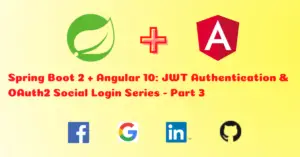
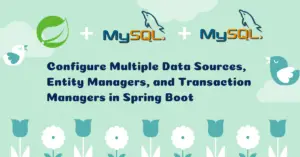

Greta Job!! Is there a youtube video for this and the angular front-end where we can get a code walk thru and description in detail.
Thanks. There is no youtube video as of now.
Hi man. Is this made in eclipse? I need to know the plugin for eclipse that are required. I can’t get the error messages to go away, I have installed Lombok and Spring Tool Suite 4 plugins for eclipse. Am I missing something?
Hi Chinna,
I figured out it was a bad lombok bug with eclipse version 2020-09. I found a new version of lombok .16 and installed it manually into libraries in build path and it works. But now my problem is, I have setup client id and client secret for google and it works. But when I sign in with my google account, I am brought to localhost:8081/login?token=XXXXX and I get a whitelabel error page 401. Any idea?
Thank you…
Hi Adam,
It looks like your spring boot application is running on port 8081. Since there is no request mapping for the /login path, you are getting the white label error page. In this demo application, spring boot will be running on the default port 8080 and angular will be running on port 8081. Hence the client redirect_uri has been configured as localhost:8081/login. So, after successful authentication, the backend will redirect to the angular client login page.
Hello, I followed the tuto and it was really helpful.
I just have the same 401.
Though, angular is running on 8081 et spring 8080.
When oauth2 authentication is successful between google and spring, I then have redirection to /login?token=XXXX.
I made a console.log on HttpErrorResponse, I have the following results:
{ timestamp: “2022-11-10T12:56:54.746+00:00”, status: 401, error: “Unauthorized”, message: “Full authentication is required to access this resource”, path: “/api/user/me” }.
So naturally angular keep the token.
Note that this problem does not occur with local user how register and login without any problem.
Thanks for your helpful as I am blocked on that since few days.
Hi, When the redirection happens to /login?token=XXX, the client has to store this token and use it for the call to “/api/user/me” endpoint. It looks like the token is missing here which is why the backend is throwing 401 Unauthorized. Can you check whether you are receiving the token in your backend in this call? If not, then we need to see why the front end is not sending the token.
Please create one blog on making payment gateway using spring boot and angular.
Here you go Integrate Razorpay Payment Gateway with Angular and Spring Boot Application in 14 Simple Steps
Hey can u help in writing the test case for authController in junit 5.
y si quiero hacer solo login y registro sin red socil, se puede omitir estos pasos?
Yes. You can skip.
I’m following that tutoria nice work
i’ve cloned Git Repo but there are 2 problem with new version of springboot
WebSecurityConfigurerAdapter is deprecated and it make a loop when tring to execute it so it get blocked
how can be fixed?
┌─────┐
| webSecurityConfig (field private org.springframework.security.core.userdetails.UserDetailsService oscurodrago.springboot.config.WebSecurityConfig.userDetailsService)
↑ ↓
| localUserDetailService (field privatecom.javachinna.service.UserService com.javachinna.service.LocalUserDetailService.userService)
↑ ↓
| userServiceImpl (field private org.springframework.security.crypto.password.PasswordEncoder oscurodrago.springboot.service.UserServiceImpl.passwordEncoder)
└─────┘
Please move the following bean declaration from
WebSecurityConfigtoWebConfigas I have already fixed in the latest project here.@Beanpublic PasswordEncoder passwordEncoder() {
return new BCryptPasswordEncoder(10);
}
Hi Sir, please I have this error with oauth2 login when I make console.log in auth.inspector on HttpErrorResponse.
{ timestamp: “2022-11-10T12:56:54.746+00:00”, status: 401, error: “Unauthorized”, message: “Full authentication is required to access this resource”, path: “/api/user/me” },
Hi,
I have a few questions:
1. How to get user picture if we are using Google Account for authentication?
2. How can we get actual access token which have been validated by Social Login Provider?
Many thanks.
Hi Sir,
I have followed the steps for user registration. But as WebSecurityConfigurerAdapter is deprecated, I have used SecurityFilterChain. But getting below error. In pom xml file, this dependency already added. Could you please help me on this issue?
***************************
APPLICATION FAILED TO START
***************************
Description:
Parameter 0 of method setFilterChains in org.springframework.security.config.annotation.web.configuration.WebSecurityConfiguration required a bean of type ‘org.springframework.security.oauth2.client.registration.ClientRegistrationRepository’ that could not be found.
Please find the below securityFilterChain I have used.
@Bean
public SecurityFilterChain filterChain(HttpSecurity http) throws Exception {
http
.cors()
.and()
.sessionManagement().sessionCreationPolicy(SessionCreationPolicy.STATELESS)
.and()
.csrf().disable()
.formLogin().disable()
.httpBasic().disable()
.exceptionHandling()
.authenticationEntryPoint(new RestAuthenticationEntryPoint())
.and()
.authorizeRequests()
.antMatchers(“/”, “/error”, “/api/all”, “/api/auth/**”, “/oauth2/**”).permitAll()
.anyRequest()
.authenticated()
.and()
.oauth2Login()
.authorizationEndpoint()
.authorizationRequestRepository(cookieAuthorizationRequestRepository())
.and()
.redirectionEndpoint()
.and()
.userInfoEndpoint()
.oidcUserService(customOidcUserService)
.userService(customOAuth2UserService)
.and()
.successHandler(oAuth2AuthenticationSuccessHandler)
.failureHandler(oAuth2AuthenticationFailureHandler);
http.addFilterBefore(tokenAuthenticationFilter(), UsernamePasswordAuthenticationFilter.class);
return http.build();
}
Hi, there could be an issue with your application.properties file. Can you check if it has all the social login provider properties configured? for example,
# Social login provider props
spring.security.oauth2.client.registration.google.clientId=
spring.security.oauth2.client.registration.google.clientSecret=
And if you are using a spring profile, please make sure you are running the application with the right profile.
Great work.
i followed all your steps to implement social login.
i used Spring Boot 3.2 and Spring 6.2.
I am stuck at Redirecting to http://localhost:8081/login?token=token
kindly help me to get out of this error